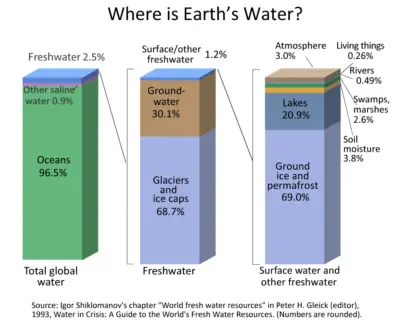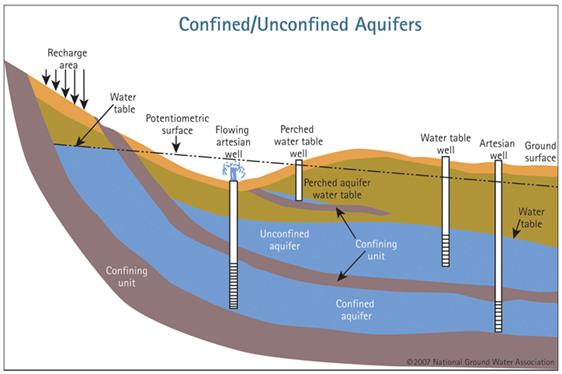When demand for freshwater is unmet, people experience Water Scarcity, a familiar term for problems happening in the world today, in fact, millions of people don’t have enough freshwater to survive in numerous parts of the world depending on location. What is Water Availability?
Water availability is the quantity of water that can be used for human purposes without significant harm to ecosystems or other users. Consideration is given to demands from human and ecosystem needs, equitable apportionment of water among uses, and indicators of stress to the water resource.
Freshwater is moving in a constant motion on the Earth between the atmosphere, oceans, rivers, and streams, in snowpacks and ice formation even underground where it forms pockets and reservoirs both as surface water and groundwater, for agriculture, human consumption, industry, and energy generation that is critical.
Types of Water on Earth
 There has been much said over the years about the importance of freshwater. 71% of the world’s surface is covered with water. Water also exists where you can’t see it such as underground and in the air as water vapor. The most important fact about water is that it is a finite source.
There has been much said over the years about the importance of freshwater. 71% of the world’s surface is covered with water. Water also exists where you can’t see it such as underground and in the air as water vapor. The most important fact about water is that it is a finite source.
Only a small percentage is usable by humans 0.03% and some of that water is unattainable. The rest, the other 99.7 percent is in the oceans, soils, icecaps, and floating in the atmosphere. The majority of freshwater that is used by humans is located underground and from surface water from rivers and lakes which is a small portion compared to the total amount of earth’s water or sources of water on earth.
- Ocean water: 97.2 percent
- Glaciers and other ice: 2.15 percent
- Groundwater: 0.61 percent
- Freshwater lakes: 0.009 percent
- Inland seas: 0.008 percent
- Soil Moisture: 0.005 percent
- Atmosphere: 0.001 percent
- Rivers: 0.0001 percent.
The earth is considered a closed system meaning that very little matter, including water, ever leaves or enters the atmosphere; the water that was here billions of years ago is still here now. But, the Earth cleans and replenishes the water supply through what scientists call the hydrologic cycle. The chances of you drinking what the Caveman used as a water source is likely true. For this reason, civilizations were built on or near Surface Water like rivers for supplying their needs for drinking, living, and agriculture.
Where is Freshwater Located
Less than three percent of Earth’s water is considered freshwater. According to the U.S. Geological Survey, most of that three percent is inaccessible. Over 68 percent of the fresh water on Earth is found in icecaps and glaciers, and just over 30 percent is found in groundwater. Only about 0.3 percent of our freshwater is found in the surface water of lakes, rivers, and swamps.
Depending on where you are located in the world dictates the availability of freshwater that is available to you. Where I live in the northeastern part of Pennsylvania, Aquifers provide high-quality water in many areas, along with The Delaware River which is also a major supply source of fresh water supply. Freshwater availability is the quantity of water that can be used for human purposes without significant harm to ecosystems or other users.
Approximately 69 percent of Earth’s freshwater is locked away in the form of ice in glaciers and polar ice caps, and another 30 percent of Earth’s freshwater is under the surface in the form of groundwater. That leaves only about 1 percent of Earth’s freshwater is readily available for human use.
Unfortunately, the available surface fresh water is not equally distributed throughout the world. Brazil, Russia, Canada, Indonesia, China, Columbia, and the United States have most of the world’s surface freshwater resources. As a result, approximately one-fifth of the world’s population lives in water-scarce areas where, on average, each person receives less than 1,000 cubic meters (35,315 cubic feet) of water a year. This lack of water affects people’s access to clean, usable water, as well as the economic development and geopolitics of different areas National Geographic
This unequal distribution of freshwater is the main reason why areas throughout the world don’t have enough clean safe water to sustain life or to use for agriculture. Over 2 billion people around the world don’t have access to clean potable water. More importantly, lack of access to clean drinking water leads to more than 3 million deaths every year.
These problems with the availability of freshwater supply lead to conflict and economic problems as most freshwater are used for agriculture besides drinking water and can happen in the richest of countries like the Southwestern part of the United States where there is ongoing drought and overpopulated areas that are drying up the Colorado River system.
This system supplies water to Arizona, California, Nevada, Colorado, New Mexico, Utah, and Wyoming, and because of rising temperatures and growing population depletes the water supply that feeds the cities and towns along with the farms that can’t irrigate any longer.
There are studies through NASA satellite imagery that show in the last few decades freshwater availability is changing in regional storage moving and collecting into different areas of the earth that can be predicted and modeled that show an end result that could cause major problems in the future for populations of people spread out through different parts of the earth. These changes are being brought on by:
- Climate Changes
- Human Activity
- Natural Variability
Artesian Aquifer
An Artesian Aquifer can be a Confined aquifer containing groundwater under positive pressure. An artesian aquifer has trapped water, surrounded by layers of impermeable rock or clay which apply positive pressure to the water contained within the aquifer. A well drilled into such an aquifer is called an artesian well. The unique thing about the Artesian Aquifer is that the freshwater fed by the underground source of spring water doesn’t need to be pumped to the surface like the traditional drilled water well.

An Unconfined Aquifer is normally exposed to the surface partially or fully filled. Artesian water is really not different from other groundwater, except for the fact that it flows to the land surface because the pressure in the rocks underground forces it to the surface. But, having water flow to the surface naturally is a handy way to tap groundwater resources.
Groundwater in aquifers between layers of poorly permeable rock, such as clay or shale, may be confined under pressure. If such a confined aquifer is tapped by a well, water will rise above the top of the aquifer and may even flow from the well onto the land surface. Water confined in this way is said to be under artesian pressure, and the aquifer is called an artesian aquifer.
Groundwater
Groundwater is defined as water that is found beneath the surface of the Earth in conditions of 100 percent saturation if it is less than 100 percent saturation, then the water is considered soil moisture. Ninety-eight percent of Earth’s available freshwater is groundwater.
Groundwater is water that exists underground in saturated zones beneath the land surface. The upper surface of the saturated zone is called the water table. Contrary to popular belief, groundwater does not form underground rivers. It fills the pores and fractures in underground materials such as sand, gravel, and other rock, much the same way that water fills a sponge.
If groundwater flows naturally out of rock materials or if it can be removed by pumping in useful amounts, the rock materials are called aquifers. Groundwater moves slowly, typically at rates of 7-60 centimeters (3-25 inches) per day in an aquifer. As a result, water could remain in an aquifer for hundreds or thousands of years. Groundwater is the source of about 40 percent of water used for public supplies and about 39 percent of water used for agriculture in the United States. according to USGS
Surface Waters
The easiest water to see and access is considered Salt and Fresh Surface water that covers the surface of the earth. The world’s surface water which is only about 1% freshwater resources, is in rivers, lakes, creeks, ponds, ice caps, and snow—which are vitally important to the everyday life of not only people but to all life on the Earth. Most of the surface water on the earth is Ocean water.
And, of course, surface water is an intricate part of the water cycle, on which all life depends. Still, the percent of freshwater that is available on the surface of the earth is very small. The water found at the Earth’s surface in lakes, rivers, streams, ponds, and swamps makes up only 0.3% of the world’s freshwater. 68.7% of the fresh water on Earth is trapped in glaciers.
The vast majority is produced by precipitation and water runoff from nearby areas. As the climate warms in the spring, snowmelt runs off towards nearby streams and rivers contributing to a large portion of our fresh drinking water. The force of gravity controls the movement of rivers and streams from higher to lower altitudes.
Surface Water is more involved with the hydrologic cycle or the water cycle is a graphic representation of how water is recycled through the environment. Water molecules remain constant, though they may change between solid, liquid, and gas forms. Drops of water in the ocean evaporate, which is the process of liquid water becoming water vapor. Evaporation can occur from water surfaces, land surfaces, and snowfields into the air as water vapor. This water is counted as freshwater and is 0.001 percent a contributing factor. It could end up in Groundwater or Surface Water.
Is there a Water Scarcity in America?
Scientists say yes studies show:
H2O sources in the US won’t last 5-10 yrs.
Colorado River (drying up) from overuse
Lake Mead in Cal. provides H2O to over 22 million people in the Western US is (drying up)
Eastern Maryland (Salt Intrusion)
Nevada (draught)
New Mexico(draught)
Flint Michigan (infrastructure) …………………………………………………………………………………………………………………. Read more
JimGalloway Author/Editor

References: National Geographic-Surface Water
USGA–What is Groundwater
